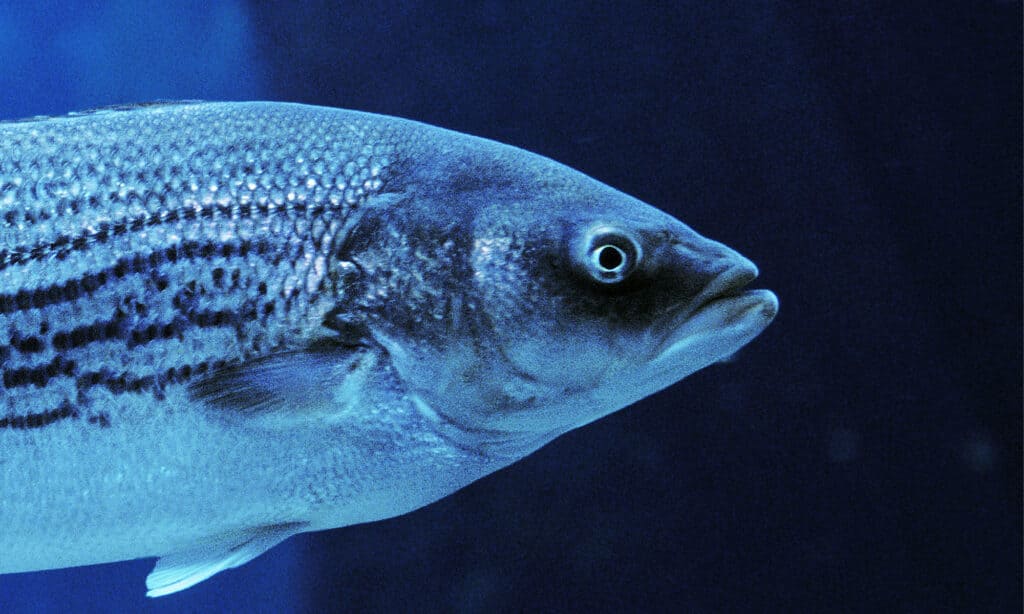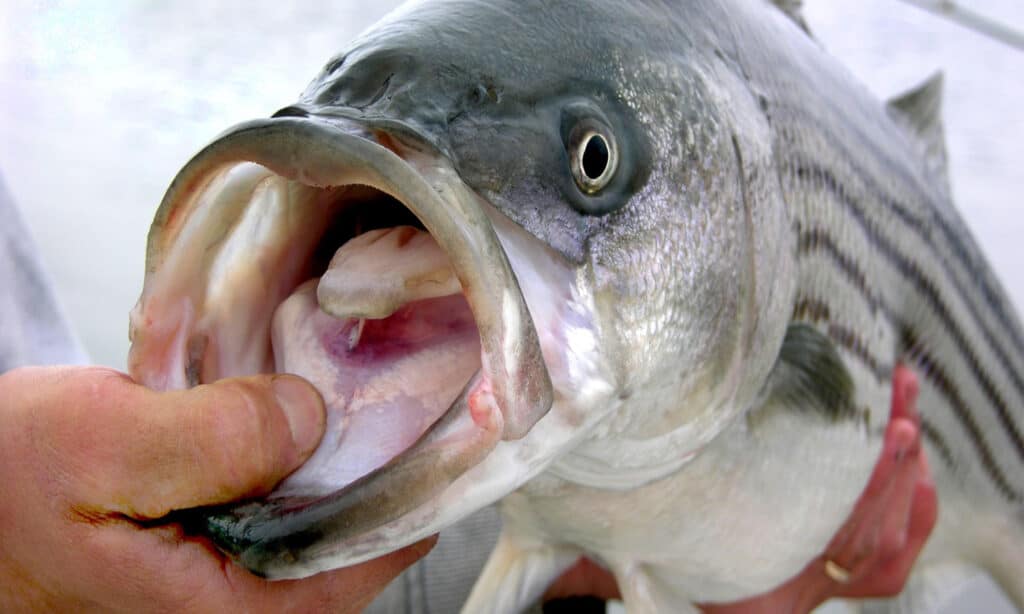Fishing in Louisiana is more than a hobby; it’s a culture and way of life. With a coastline covering 77,000 miles, Louisiana is the dream destination for anglers. It’s nicknamed the Sportsman’s Paradise, which is an accurate appellation if you consider the state’s fishing history. With more than 224 fish species across Louisiana’s freshwater, brackish, and marine water bodies, many record-breaking fish species have been caught here. There’s an extensive record of massive species caught in Louisiana, including the largest striped bass ever caught in the state. Read on for interesting facts about the striped bass and the largest striped bass ever caught in Louisiana.
About the Striped Bass

Striped bass naturally live in saltwater ecosystems.
©iStock.com/slowmotiongli
The striped bass is also called striper, rockfish, or linesider. There are two naturally occurring strains of this fish native to different regions. One is native to the northern coast of the Gulf of Mexico. This is known as the Gulf Coast striped bass. The second variety is native to the Atlantic coast of North America. This is the Atlantic striped bass.
Striped bass naturally live in saltwater ecosystems but would migrate to rivers and other freshwater bodies to spawn. This anadromous life cycle suggests that this fish can survive in freshwater habitats. They have since been introduced successfully to freshwater reservoirs and lakes in different states of the US, including states that lack natural access to saltwater bodies. However, the striped bass is naturally abundant in Louisiana’s deep blue waters and has been caught severally by anglers.
This fish has a long body, and the color can range from dark gray to steel gray to green. The back has an almost-black color, while the sides may be dark gray or silver. There’s usually a horizontal line along the fish’s lateral line. Also, the gill plates can have up to eight distinct horizontal lines running all the way to the tails. The striped pattern formed by these lines is the reason for the fish’s name.
Apart from the area they’re native to, the major difference between the two strains of striped bass is the varying number of dorsal fin rays they have. Their lateral line scales are also configured differently, but they’re still largely considered the same fish species by most fisheries biologists.
Largest Striped Bass Ever Caught in Louisiana

The largest striped bass caught in Louisiana was 47.5 pounds.
©Steve Brigman/Shutterstock.com
There’s a long list of record catches of striped bass in Louisiana, dating back to the late 1900s. However, the largest one ever caught was at Toledo Bend in August 1991. An angler named James L. Taylor caught the massive fish. It weighed 47.50 pounds. This catch broke the record that was previously made by Daniel F. Thompson in May 1990 when he caught a striped bass in Louisiana that weighed 44.50 pounds. That record only lasted 15 months.
On the global stage, the largest ever striped bass to be caught weighed 81 pounds and 14 ounces. It was captured in August 2011 by Gregory Myerson at the Long Island Sound, off Westbrook.
There’s also a different record for the world’s largest landlocked striped bass. It weighed 69 pounds and nine ounces and was caught by James Bramlett in February 2013 along the Black Warrior River in Alabama.
How To Fish For Striped Bass in Louisiana
When it comes to sport fishing in Louisiana, striped bass is one fish with significant value. There are several methods used for angling striped bass in Louisiana. These include surf casting, trolling, and bait casting using dead or live bait. Bait casting is quite effective because striped bass can feed on various animals that can be used as bait, such as clams, eels, bunker, herring, sandworms, bluegill, crayfish, mackerel, shad, and bloodworms.
For the largest striped bass ever caught in the world, the angler, Gregory Myerson, used a live eel as bait, and the giant fish got hooked. It struggled for about 20 minutes before it was finally boated. It was discovered that the fish had another hook and leader in its mouth. This was an indicator that it had been hooked once by another angler. But it managed to free itself before being brought on the boat.
The 81-pound fish was 54 inches long with a 36-inch girth. This large catch was declared the new world record for striped bass by The International Game Fish Association on October 19, 2011. It beat the previous record, a 78.5-pound striped bass caught at the Atlantic City in New Jersey, set by Albert McReynolds on September 21, 1982. Albert also lured the fish with artificial bait, and the fish wrestled for 1:20 before he could boat it.
Best Places To Find Striped Bass In Louisiana
Louisiana’s 77,000 miles of coastline means more than enough water for everyone to fish. If you enjoy fishing for striped bass, consider visiting Louisiana. You’ll likely enjoy every second of your time in the Sportsman’s Paradise with the numerous rivers and lakes filled with these fish. Here are examples of places you’re guaranteed to find striped bass in Louisiana.
Toledo Bend
Toledo Bend is where the largest striped bass in Louisiana was caught. It also has the largest bass population in the state, so it’s not surprising that it’s top of the list. This large reservoir is about 110 feet deep and covers 1,200 miles of shoreline. It’s a popular spot for anglers, but there’s more than enough striped bass population for everyone.
The best time for striped bass fishing at Toledo Bend is the summer period and early fall. You can use topwater lures to catch them along the channels. Another effective way to fish for striped bass here is by creating live shiners around duck blinds at night.
Ouachita River Lakes
Ouachita River Lakes are among the best places to catch striped bass in Louisiana. The river lakes also make fishing easier due to the trees and stumps acting as a cover. You can use crankbaits if you’re angling on the river, but topwater frogs might work better if you’re on the lake. You can throw them in small channels or vegetation to lure the target.
Red River
Red River is a constantly changing aquatic environment, so you never get the same outlook twice. However, even though the tides, water, and weather are constantly changing, there’s still a large population of bass, including striped bass, in the river.
The speedy flow of the water is an advantage for anglers because these large fish often move away from the main channel towards the eddies and pools in search of small fishes taking refuge in that part of the river. Also, since it’s a location with lots of forage fish, it’s likely to have many striped basses too.
Lake Salvador
Lake Salvador is one of the popular locations for striped bass fishing in Louisiana. It’s a lake covered with aquatic vegetation on the surface, but it also has lots of bait fish, which can make your bass-angling much easier.
If you’re angling in this location, you should focus on the tides as they rise and fall. The wind also plays a crucial role, so you should consider fishing on shores opposite the wind direction. Striped bass in this area feeds primarily on thick crawfish, rodents, small fish, and insects. So you can use crankbaits and topwater lures for fishing on this lake.
Conclusion
The striped bass is one of the most popular game fish. Several record-breaking catches have been recorded across different parts of the country. Although the largest striped bass ever caught in Louisiana was more than two decades ago, there’s a good chance an even bigger striped bass is out there swimming around in the waters of Louisiana, waiting for the next person to make that big catch and set a new state record.
Up Next
- Discover the Largest Bass Ever Caught
- The Largest Largemouth Bass Ever Caught in Mississippi
- Discover The Largest Striped Bass Ever Caught in Arizona
The photo featured at the top of this post is © slowmotiongli/Shutterstock.com
Thank you for reading! Have some feedback for us? Contact the AZ Animals editorial team.






